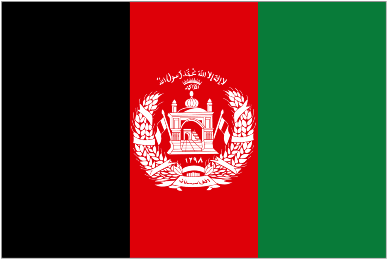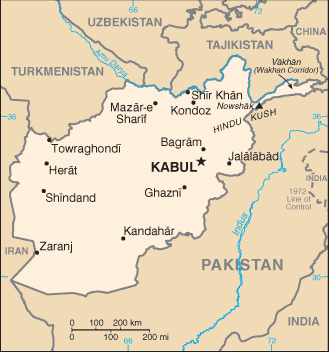- Population: 26 million (UN, 2005)
- Capital: Kabul
- Area: 652,225 sq km (251,773 sq miles)
- Major language: Pashto, Dari (Persian)
- Major religion: Islam
- Life expectancy: 46 years (men), 46 years (women) (UN)
- Monetary unit: 1 Afghani = 100 puls
Afghanistan has a worldwide media-created perception that the whole country is a “war zone” with men on jeeps with AK 47’s and RPG’s. Not a lot dares to go behind that mask of war and religious extremism to discover it for what it truly is. The truth behind the sensationalism and the headlines, 99.95% of Afghans are actually not in the Taliban. That information probably is in itself surprising, but that the Afghans are a pure and genuine people renowned for their hospitality as they are known for their ability to repel foreign armies, even more so.
GEOGRAPHY & CLIMATE
Afghanistan (33 00 N, 65 00 E) has a dramatic mountain scenery like the Hindu Kush Mountains with ongoing plains in the north and the southwest, and a desert in the south of Kandahar. The highest point is Nowshak elevated 7,485 metres above sea level found in the tall peaks of the northern Wakhan Corridor. The lowest point is the Amu Darya at 258 metres.
Afghanistan’s total area of 647,456 km2 located its particular spot in Southern Asia very distant from the moderating effects of the oceans influences its continental climate. Continental climate indicates bitter-cold winters below freezing temperatures and extremely hot summers which can be terribly unbearable for lower elevations where the heat can exceed 50°C/120°F. In higher terrains, such as Kabul, the national capital, summers are hot at 30°C or 90°F, whereas winters are around 0°C or 30°F. Therefore, the best months to be here in Afghanistan are in the months of April, May, and September when it’s neither too hot nor cold. Just as security will be a concern, the traveller must also be weary of natural hazards in the region such as damaging earthquakes (in the Hindu Kush), floods from deforestation, and droughts resulting to limited water resources, desertification. Air and water pollution also cause substantial trouble to the country.
PEOPLE & CULTURE
With the geographical composition of mountains that act as dividers to the region, Afghanistan as a result is an ethnically diverse country where the largest groups are the Pashtuns (42%), Tajiks or Persians (27%), Hazaras (9%), and Uzbeks (9%). Behind the headlines of violence and tribal politics, the population of 33,609,937 Afghans are, in truth, a traditionally honest and caring race of people who are peacefully struggling to get on with their own difficult lives.
However, religion is more homogenous than diverse with 99% of Afghans practicing Islam-Sunni, 80% and Shi’a, 19%. Other religions are Judaism, Zoroastrianism, Hindus and Sikhs, while a small population of almost 8,000 practice Christianity in secrecy. There are two official languages that are most commonly spoken: DARI, an Afghan dialect of Persian with almost 17 million speakers, 50%, and PASHTO spoken by 35% of the populace. Turkic languages such as Uzbek and Turkmen are spoken by a significant 11% while the rest are some 30 minor languages. Dari is the language of the capital Kabul, and is used generally for cultural expression, business, and politics. ENGLISH, the language of opportunity, is the primary foreign language taught in the country. An explosion of English studies began upon the fall of the Taliban in 2001 and also as a result of preference for a handful of employment opportunities.
FOOD & ATTRACTION
Tourism may seem like frivolous activity in these parts but be assured that there are places that are safe to visit. The amazing part of this is that Afghanistan will never be a mainstream tourist destination but it is gradually stepping up to the plate as a major destination for world frontier, with great trekking sites from all angles: the mountains, the community, and the people. Bamiyan, which is 8 hours from Kabul, is endowed with blue sapphire lakes, golden cliffs, and fingers of cascading waters. The Bamiyan Valley is home to the country’s first commemorated national park, the Band-e Amir and is also where mountaineers trudge to visit the 1,500-year-old giant Buddha statues. The backpacker will also surely appreciate coming across the local fauna such as the ibex, urial, wolves, foxes, fish, and various mammal and bird species such as the Afghan snow finch. Other places of interest are Farah and Jalalabad, Faiizabad and Khash, Maimana, Mazar-e Sharif, and Ghizna. For certain, a visit to the country will not only render a fantastic experience but a means to help the locals build a better future.
Afghan cuisine is unchartered territory to the rest of the world, but Afghan food is similar to cuisines in Central Asia and the Middle East. The philosophy behind the food is basic, “do with what is readily available,” which means simply that the cuisine is based upon the nation’s chief crops or vegetation. Rice, food for the royalty, is a celebrated staple that the wealthy Afghan families would delightfully consume once a day. Palao, the national dish, is rice with meat, stock, and vibrantly topped with fried raisins, slivered carrots, and pistachios (cashews or almonds), coriander and spices. Khameerbob is similar to Chinese dumplings topped with a yogurt or goat cheese sauce, but is a ravioli doppelganger when topped with a tomato-based sauce. Afghan kebab is a standard restaurant dish as well as a famous street meal, where lamb is commonly used. Kebab is normally eaten with naan, the Afghan round white bread. Naan can also be eaten with meat, pickled fruits and vegetables, or pepper sauces, chatney.






Leave A Response